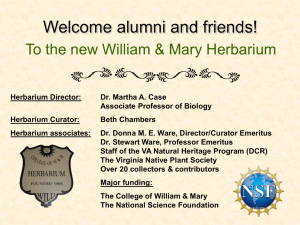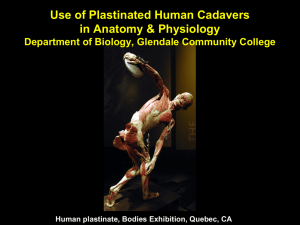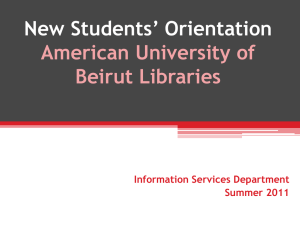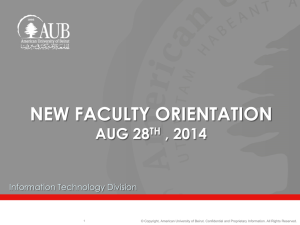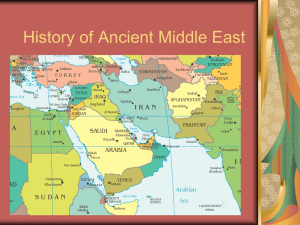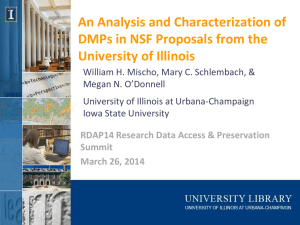The Future of the Post Herbarium
advertisement
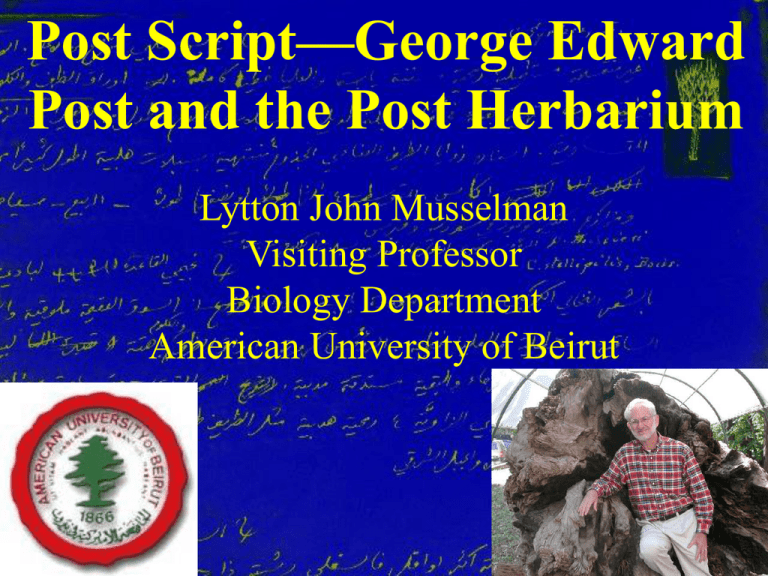
Post Script—George Edward Post and the Post Herbarium Lytton John Musselman Visiting Professor Biology Department American University of Beirut To find George Post we must travel to Beirut and down Post Street. . . . . . . . . and to the American University of Beirut (AUB) Post Script—George Edward Post and the Post Herbarium I. The life of George Post. II. His association with the Syrian Protestant College. III. The botanical activities of Post. Post Script—George Edward Post and the Post Herbarium IV. The herbarium of George Post. V. The Post-Post Post Herbarium. Post Script—George Edward Post and the Post Herbarium VI. The Post Herbarium and its role in floristic and biodiversity surveys in Lebanon, Syria, and the region. VII. The future of the Post Herbarium. Post Script—George Edward Post and the Post Herbarium I. The life of George Post. George Edward Post 1838-1909 Born in New York City, son of Harriet Beers and Alfred C. Post, a prominent surgeon. Studied Latin at age of six. Graduated with honors from City College of New York in 1854 at age 16. M. S. degree in 1857. M. D. degree conferred in 1860. Ordained a minister in 1861. D.D.S. awarded in 1863. The Post family lived in New York state. Sent as a medical missionary to Syria in November 1863. Settled in Tripoli,began medical practice and study of Arabic. Remained in Tripoli from 1863 to 1868 including a return to the United States for health reasons. Health concerns led to giving up his missionary position in 1868. Modern day Tripoli from the harbor. Post Script—George Edward Post and the Post Herbarium II. His association with the Syrian Protestant College (later AUB). Appointments. The “Lewis Affair.” Post was appointed Professor of Surgery and Botany in 1869. He remained in this position, under various titles, until his death in 1909. George Post in the 1870’s. Edwin Lewis George Post and the “Lewis Affair”. Edwin Lewis was Professor of Chemistry and The faculty of the Syrian Protestant Geology. College in the 1870’s. Unlike Post, Lewis was a popular teacher. He was chosen to give the commencement address in 1882. In his speech, Lewis spoke of three great scientists of the age: Lyell, Pasteur, and Darwin. Darwin was “. . . an example of the transformation of knowledge into science by long and careful examination and accurate thinking.” An uproar ensued. Lewis was censured by the mission society running the Syrian Protestant College. Students went on strike. Faculty resigned in support of Lewis. Most prominent among those resigning was Cornelius Van Allen Van Dyck who had worked closely with Post. C. Van Dyck was Professor of Chemistry and Surgery (not to be confused with William Van Dyck, his son, also a professor of surgery.) Cornelius Van Dyck was one of the greatest scholars in the Middle East and translated many books into Arabic, including the Bible. His translation remains one of the most widely used in the Arab world. Van Dyck had more than a passing interest in botany and participated in an expedition to the source of the Jordan River in 1877. His familiarity with plants and work with Post led to a Bible translation more botanically accurate than many. The resignation of the Van Dycks in support of Lewis threatened the future of the Syrian Protestant College. Post took a strong stand against Lewis’ supporters including his friend and colleague, C. Van Dyck. Student strikers supported Van Dyck against Post. Student complaints against Post charged him with: “cruelty, avarice, . . .injurious to the peace of the college.” One of their demands was the demotion of Post to the rank of instructor. Within a year the controversy subsided, new faculty were hired, the student strike was broken, and Post remained in his university position, firmly established in his anti-Darwinian and authoritarian stance. It is telling that in his acknowledgements in the flora, Post glaringly omits Van Dyck but thanks “. . . Professors Porter and Day. . . genial companions . . .of his journeys. . . who aided his studies. . .” Papaver postii Fedde endemic to Cyprus III. The Botanical Activities of George Post 1857-1908 The Botanical Activities of George Post 1857-1908 Early years 1857-1868 Syrian Protestant College 1869-1909 Expeditions Exchange Correspondence Early Years Little is known of Post’s formal training in botany. Physicians trained in the Papaver postii mid-1800’s were required to take Materia medica and other plant-oriented courses. Post began an herbarium as a teenager, perhaps in company with his father who also collected plants. What is an herbarium? A museum of dried plants. Examples of herbarium labels Label of Alfred C. Post? Early label of George Post Soon after settling in Tripoli, Post collected plants. Between 1866 and 1869 he visited several areas in modern day Lebanon and Syria. Expeditions Post participated in several expeditions for natural history and archeology. He visited Sinai in 1883 and further south. Some specimens were collected at the pyramids. Post had an interest in archeology. He led to an expedition to Palmyra (Tadmur) in 1890. Cyprus 1898 Most of his collecting was in the mountains. Papaver postiii Fedde On the trail of George Post. He named several plants after the Troodos region of Cyprus. Papaver postii Fedde Among taxa he described from Cyprus are: Calamintha troodii, Cyperus cyprius, Dianthus multipunctatus Ser. var. troodi, Euphorbia troodii, Ferula cypria, Phlomis cypria, Saponaria cyprica, Scabiosa cyprica, Sideritis cypria, and Teucrium cypricum. Papaver postii Fedde Post received many specimens from a Mrs. Shepard, a physician living in Aintab. He named several plants in her honor including Achillaea shepardi, Astragalus shephardi, Campanula shepardi,Centaurea shepardi, Erigeron shepardi, Knautia shepardi, Medicago shepardi, and Nepeta shepardi. Aintab Post incorporated Shepard’s specimens under his own name. Labels from the type Specimen of Ferulago kurdica. He also received specimens from Mardin and vicinity from an unknown source (Mrs. Shepard?) and named these new species: Nepeta mardinensis and Verbascum mardinense. Post collected many plants from the Hauran Region southeast of Damascus and named new taxa. The Hauran region of Syria These include Chaerophyllum auranitacum, Cynara auranitica, Dianthus auraniticus, and Ferulago auranitica. Post visited western Turkey on several occasions to represent the medical college to Ottoman authorities and also perhaps to visit his son, Bartram Van Dyck Post, a Professor of Botany and Zoology at Robert College. Bartram Van Dyck Post carried on the Post family tradition of botany. He published one of the first floras of the Bosphorus region. Examples of Post’s labels from Turkey. His last trip to Turkey was apparently in 1903. Correspondents-Exchange European correspondents included Balfour Blanche Boissier (collected by Haussknecht) Gaillardot Hulsen LeTourneux Tauscher Schweinfurth, who sent plants from Egypt. Inscription in Schweinfurth’s Flora Aethiopiens to Dr. G. Post by J. Ascherson Specimens obtained by Post are sought by scientists documenting disappearing flora in their countries. For example, a botanist in Istanbul, studying vegetation changes in the Bosphorus region, inquired about endangered species that might be in the Post collection. Two species were found Her response indicates the value botanists recognize in the Post Herbarium “. . .if you have got Aznovor’s specimens [in] Beyrut, they are treasure. Please [protect] Aznovour’s collections very well.” North American Exchange Post participated in an exchange program (from Harvard University?) that published a list of species for exchange. Post tried to obtain as many U. S. specimens as possible Many well known U. S. collectors are represented in Post’s collection. “Plants which I have are marked out” These collectors include W. M. Canby A. H. Curtis D. C. Eaton C. Mohr E. S. Palmer and many others. Loranthus from Australia. Ex herbarium of D. C. Eaton. As a result, the Post Herbarium contains a surprising array of plants from many different parts of the world. Annotations The numerous annotations on specimens in the Post Herbarium attest to its importance in plant biology in the region. Annotations Many specimens were annotated by Paul Mouterde. Other botanists include N. Vavilov, St. Petersburg Alexander Eig, Jerusalem Correspondence-Letters Correspondence of George Post Post wrote to botanists at Kew (Baker), St. Petersburg (Winkler), Geneva (Autran, Barbey, Boissier) and elsewhere. William Barbey, son-in-law to Edmond Boissier, was one of Post’s most frequent correspondents. Many Post specimens have both a Post number and a Barbey number. Post named several plants after Barbey including Astragalus barbeyanus, Eragrostis barbeyi, Ferula barbeyi, Hieracium barbeyi, and Verbascum barbeyi. His correspondence was extensive. 133 letters are preserved at Geneva Correspondence found in the Post Herbarium includes Schweinfurth Bornmüller Autran Post was strongly influenced by Edmond Boissier. Arrangement of families in his flora and in his herbarium follow that of Flora Orientalis Post’s copy of Flora Orientalis marking Boissier’s stand on Darwinism. “For my part, I never accepted to any degree the Darwinian theory. . . .” Plants Named for George Post Genera Postia Boiss et Blanc. Postiella Kljuykov Species Centaurea postii Boiss. Papaver postii Fedde Tracheliopsis postii Buser Did Post “Specialize” in any groups? His interest spanned all angiosperms but he named more species (14) of Verbascum than any other group including: Verbascum aintabicum, V. aliciae, V. antari, barbeyi, V. boissieri, V. caudatum, V. fruticulosum, V. gadarense, V. karyeteini , V. macranthum, V. mardinense, V. palmyrense, V. porteri, and V. qulebicum. Publications of George Post In addition to his better known botanical works, Post edited a medical journal in Arabic and translated several books. List of publications in first edition of the flora Post’s concordance of the Bible, still in print in the 1970’s. Post’s flora in Arabic 1883? Biscutella from the Arabic flora. (Apparently volume II never appeared). Post’s handwritten manuscript treating Cephalaria Post’s best known work, edition I of the flora 1884. The second edition was produced by J. E. Dinsmore in the 1930’s. The Post Herbarium forms the basis for this flora. “. . few men would have attempted to carry such a book through to press in Syria, fewer still would have succeeded so triumphantly.” Review of Post’s flora, source unknown, pasted in Post’s copy. At the time of his death, he had completed the manuscript of a dictionary of botany and zoology that was never published. Most of the plants named by Post were described in a series called Plantae Postianae published by the Bossier Herbarium in Geneva. Post’s Latin description of Statice palmyrensis. Post Script—George Edward Post and the Post Herbarium IV. The herbarium of George Post. In 1904, the herbarium was moved to Science Hall (later called Post Hall) where it apparently remained until 1953. It is now housed in the Faculty of Agriculture. Post Hall on the AUB campus Let’s go there. . . . Welcome to the Post Herbarium American University of Beirut Nada Sinno Saoud Components of the Collection 1.The herbarium of George Post. 2. Specimens added after Post, i.e., after 1909. Post Collection • • • • • • • Specimens collected by George Post. Specimens obtained by exchange. Materia Medica. Economic Botany Collection. Tropical Ferns-Dodge collection. Bryophytes from Ceylon and Hawaii. Fungi from Budapest Museum. The Collection of George Post • According to Dinsmore (1932), the Post collection contains an estimated 20 000 sheets. This includes specimens “contributed” by students. To this day, most of the sheets are Post’s specimens. • Plants obtained by exchange. The most valuable specimens are type specimens. According to international botanical code, the name of the plant is based on the type specimen. Sideritis cypria Post This is the type specimen of a species Post named from Cyprus. Wherever and however this name is used, it is linked with this single specimen. The Materia Medica collection of the Post Herbarium Materia medica was a required course for medical students to learn plants used for compound medicines. Teaching it was apparently considered equivalent to teaching an introductory course. Post asked to be released from teaching this course. Economic Botany Collection acquired by exchange of specimens with Royal Botanic Gardens, Kew in 1882 Tamarindus indicus Hematoxylin Dodge Fern Collection Cyathea dealbata Adiantum formosa Dodge Fern Collection Post’s report on the herbarium in 1889 states: “The herbarium has been enriched by a magnificent collection of ferns from all quarters of the world, gathered and beautifully mounted by the late Mrs. Stuart Dodge, and presented by her husband to the college.” Bryophytes from Ceylon and Hawaii Hypnum Hawaian Islands A collection of several hundred specimens. Collector and source unknown. Bryophytes from Ceylon and Hawaii Climacium subserratum Central Province of Ceylon Fungi from Budapest Museum Less than 100 specimens possibly obtained through contact with J. Bornmüller, who had links with Hungary. Post Script—George Edward Post and the Post Herbarium VI. The Post-Post Post Herbarium History Collections The Post-Post Post Herbarium • Alfred Ely Day was appointed Professor of Botany after Post’s death in 1909. • In 1922, the herbarium was apparently transferred to pharmacy. Day was appointed Professor of Botany in Pharmacy. The Post-Post Post Herbarium • John Edward Dinsmore of the American Colony in Jerusalem begin his revision of Post’s flora in the 1920’s. • Apparently, this led to the cataloging of all the specimens in the herbarium in the 1930’s. The Post-Post Post Herbarium Catalog prepared by Tateos V. Yegavian in 193031. Yegavian was a business student. Each sheet is recorded with name, synonym, collector, location, annotation information, and date. The Post-Post Post Herbarium This remarkable catalog provides an accurate account of the collection as it existed in the early 1930 and can be consulted to see which of the original specimens are still intact. The Post-Post Post Herbarium At least up to 1931, some curatorial work was done in the herbarium. Elie Hammam was an Instructor of Botany who Dinsmore corresponded with regarding herbarium matters. (Hamman met his untimely death falling off Mt. Sannine at age 23). The Post-Post Post Herbarium Little is known about activities in the herbarium between the time of the publication of the second edition of the flora and 1953. The Post-Post Post Herbarium By 1953, interest in the herbarium had apparently waned. It was moved to agriculture through the efforts of Winnie Edgecombe, an instructor in agriculture. The Post-Post Post Herbarium Edgecombe is best known for her two books on weeds of Lebanon Weeds of Lebanon The Post-Post Post Herbarium Most of the accessions after 1953 were from the collections of Winnie Edgecombe. The Post-Post Post Herbarium With the establishment of the Faculty of Agriculture in 1953, emphasis was placed on weeds and range plants. A small Range Management Herbarium was established. The Post-Post Post Herbarium When the School of Pharmacy was closed in 1977, Professor Charles Abu Chaar moved to the Biology Department and assumed responsibility for the herbarium. The Post-Post Post Herbarium The civil war and invasions in Lebanon led to the departure of Shaukat Chaudhry who was curating the herbarium in the 1970’s. The Post-Post Post Herbarium During the difficult war years, Professor Abu Chaar looked after the herbarium. Euphorbia macrostegia Asphodeline liburnica Aubretia libanotica Cedrus libani Iris sofarana VII. The role of the Post Herbarium in biodiversity and floristic studies onosma inChoufLebanon, Syria, and the region. Origanum libanoticum Euphorbia macrostegia Asphodeline liburnica Aubretia libanotica Cedrus libani Iris sofarana The Post Herbarium is the oldest, largest, and most comprehensive Chouf onosma herbarium in Lebanon and Syria. Vinca libanotica Origanum libanoticum Euphorbia macrostegia Asphodeline liburnica Aubretia libanotica Cedrus libani Iris sofarana Well known to botanists who work in the region, the Post Herbarium isChoufanonosma invaluable resource reflecting the scientific work of AUB faculty, most notably George Post. Vinca libanotica Origanum libanoticum Euphorbia macrostegia Asphodeline liburnica Aubretia libanotica Cedrus libani Surveys of crop relatives and other Iris sofarana useful plants in Lebanon and Syria have stimulated new interest in the Post Herbarium. Chouf onosma Vinca libanotica Origanum libanoticum VIII. The Future of the Post Herbarium The Future of the Post Herbarium In a word-Bright!! The Future of the Post Herbarium A manager has been appointed and the collection is being curated. The Future of the Post Herbarium A major effort is being placed on the location and curation of type specimens. To date, types of 133 of the 214 plants named by Post have been found. Types are being scanned and will be available on a web site. The Future of the Post Herbarium The herbarium will be upgraded, curated and housed in new facilities. It will occupy an entire floor of Post Hall. The Future of the Post Herbarium Almost 1000 square feet will be available for the new herbarium. The Future of the Post Herbarium Bust of Post in Post Hall Post Hall is named for George Post and was designed by him. The Future of the Post Herbarium “The great want of the museums is a permanent Assistant Curator, who shall not only keep present collections from deteriorating, but aid in enlarging and arranging them in such a way as shall most contribute to their educational value.” Report on the museum by Post in July 1891 The Future of the Post Herbarium “The great want of the museums is a permanent Assistant Curator, who shall not only keep present collections from deteriorating, but aid in enlarging and arranging them in such a way as shall most contribute to their educational value.” Report on the museum by Post in July 1891 George Post inspires botanists almost a century after his death. Visit the Plants of Lebanon web site at http://webfaculty.aub.edu.lb/~lm10 for checklists and images of plants of Lebanon and Syria. George Post inspires botanists almost a century after his death. Visit the Plants of Lebanon web site at http://webfaculty.aub.edu.lb/~lm10 for scanned copies of Post’s and Mouterde’s manuscripts and notes. Acknowledgements Cedrus libani Tannourine Financial support for the herbarium from the Darwin Project, AUB. Biology Department, AUB, for support and encouragement. Archives section of Jafet Library, American University of Beirut. Staff and students who work in natural areas in Lebanon, especially Tannourine Shouf and Ehden. Old Dominion University for unflagging support for three decades. Libby and John for love and support for a husband and father who loves plants. Let’s go!!

